Monday, July 23, 2012
Hula Hoop rug
Sunday, June 24, 2012
Pool Noodle Sculpture
Skewers and cut up pool noodles. EASY and fun for all ages.
I suggest getting your pool noodles from the Dollar Tree.
Tempera Paint
Pony Bead Bowls on a griddle
Cover your griddle in foil. Melt beads in a circle. Flip over a foil covered cup to cool.
The smell is less and it is easy to see how fast they are melting. It is easy to flip the foil over the cup instead of having to cool it and melt it over the cup like if you do it in the oven.
Melting Plastic Experiment
I didn't feel they melted well/evenly on the hotplate.

Thursday, April 19, 2012
Plastic Gelatin

My girls LOVED this stuff. I had never seen this recipe before. I found it in a book, Mudworks, that we checked out from the library. We had everything we needed so I made it because I didn't have to purchase anything.
Plastic jello
1 envelope unflavored gelatin
3 T water.
Food coloring
Mix ingredients and cook over medium heat (or add food coloring in later if you want swirls instead of a solid color). Stir constantly until dissolved.
Remove from heat and pour into container lids. I put mine on plastic dishes. You can use yogurt or coffee lids too. My dishes had tall enough sides I could move them after it was set a little bit. And one mixture fit all on one plate for no spills. Next time, I might but yogurt lids on a cookie sheet to contain spills and make smaller circles. (You can add food coloring at this point to and swirl with a toothpick.)
Let dry until hard. This took ours two days. It looked rubber-er at day one but at day two it was crunchy and ready to come off the plastic plate.
Then we cut them with little kid scissors and hole punched them then threaded yarn through them. They look really pretty hanging by the light. You can also color on them with permanent markers. My two year old is really into cutting yarn this week. ...like there are scraps of yarn EVERYWHERE because she is continually making bracelets and necklaces. So she loved cutting this stuff. It does rip too. She also really liked the hole punch because then she could lace the yarn through it.
Easy to mix up. Cheap ingredients. Fun to play with.
 Sculpture by my two year old.
Sculpture by my two year old.
Monday, March 19, 2012
Progress of a Personal Watercolor
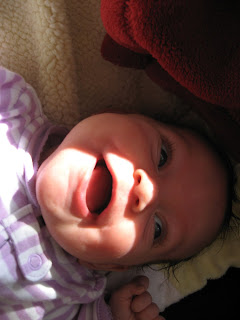 Original photo that I can't figure out how to turn.
Original photo that I can't figure out how to turn.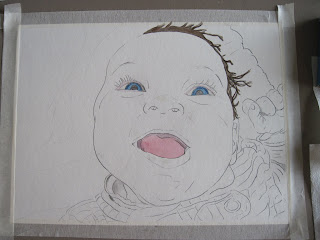 Drawing with the starting of watercolor for the eyes and mouth.
Drawing with the starting of watercolor for the eyes and mouth.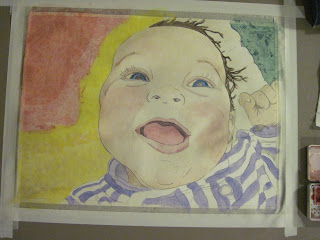 Textured background, skin color and pjs.
Textured background, skin color and pjs.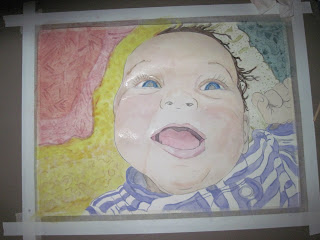 More details.
More details.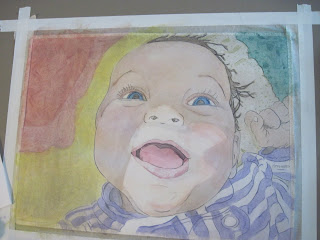 First shadow. So scary to paint with black over the majority of your painting!!!
First shadow. So scary to paint with black over the majority of your painting!!!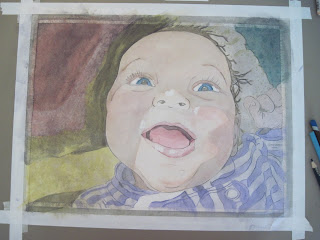 More shadows over hand and background. Remove resist on eyes, nose, lips, and cheeks.
More shadows over hand and background. Remove resist on eyes, nose, lips, and cheeks.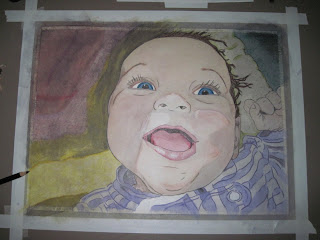
Finally, decided what to do with the background. Colored pencil details.
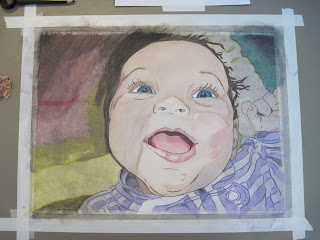 Darkening background.
Darkening background.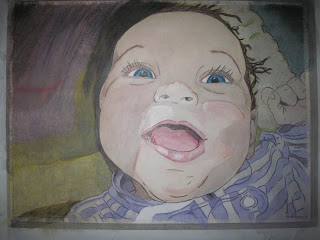
Continuing to darken background.
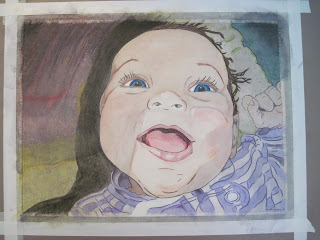 Completed.
Completed.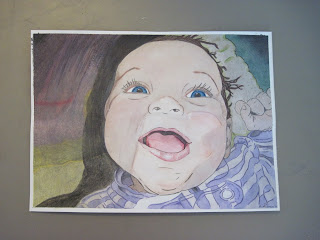
Tape removed.
I like how this completed image ended up. I feel like I am abusive to my paper with so many layers of paint and colored pencil. I would like to try a different style with no colored pencil and a lighter hand with the watercolor.
Wednesday, March 7, 2012
Crayons on Sandpaper
 Makes any simple drawing look 'artsy.' Saw HERE.
Makes any simple drawing look 'artsy.' Saw HERE.Supplies:
sandpaper
crayons
thick paper (different colors of cardstock cards work well)
iron
old rags or newspaper
Instructions:
Color on sandpaper with crayons.
Iron drawing onto thick paper.
Tips:
* This makes any artwork 'artsy.'
* Fine sandpaper makes crayons melt more together. Courser sandpaper makes it look like dots of wax.
* These make cute invites to your Art Show for your neighbors and other guests.
* Iron can be on low setting. Wax melts around 150 degrees. The cotton setting is too hot and your paper/wax will start to smoke and smell.
* Put newspaper under the paper you are ironing onto or have old rags handy to clean any messes up. The mess should be minimal.
Shrinky Dinks

YES! I love this.
Supplies:
Type #6 Plastic (clear containers from grocery stores or carry out)
Permanent Markers
Oven
Foil
Cookie sheet
Instructions:
Cut your piece of plastic.
Draw, write or trace then color the image you want.
Heat oven to 350 degrees.
Put plastic on foil covered cookie sheet.
Put in oven for 2 to 4 minutes.
Tips:
* Put foil shiny side up!
* A 6 inch piece takes 3 ½ minutes.
* It will curl up the first 90 seconds, don't worry.
Circle Sculptures

I saw THIS little sculpture related to a Gabo Abstract Sculpture instead of always being related to Calder.
I made mine with spray painted plastic yogurt lids and embroidery thread.
What if it was really big? Corrugated cardboard painted with acrylic and thick twine??
Melted Crayons

HERE , I was reminded of what fun I had melting crayons as a kid. Covering your griddle in foil allows you to use the griddle you have then dunking the paper in the wax instead of drawing on the paper over the griddle allows for multiple children to do this easily.
Supplies:
griddle
foil
crayons
wooden skewers or old kitchen utensil
paper
Instructions:
Cover griddle in foil and heat to 200-250 degrees.
Unwrap crayons
Put crayons on griddle and allow to melt. You can push them with the skewer.
Lay paper on melted crayons
Push paper down with skewer then lift edge of paper then lift with fingers
Layout to let cool
Tips:
*Smaller sheets of paper work the best (1/4th of sheet of paper or smaller)
*Thicker paper is necessary because of the weight of the wax. (Copier paper won't work.)
* Turned the temperature up on the griddle is fun but it will start to smoke and smell.
* Eventually everything turns brown/black but it takes a lot of crayons and mixing for this to happen.
* This method is better than laying the paper and drawing on it. It is easy/faster to take turns and the images look more 'artsy.'
* Wax cools quickly and scraps up easily.
* My two year old did not burn herself on the griddle. I simply went over the rules and stood by her. After a few examples, she could do it all herself even put on and lift off the paper.

Wire and Tissue Paper Sculpture
 I saw THIS picture and made a kid's version. (Sorry about the poor photo.)
I saw THIS picture and made a kid's version. (Sorry about the poor photo.)Supplies:
Wire
Tissue Paper
Brushes
Water
Glue
Small containers
Plastic bags
Instructions:
Cut several lengths of wire for each child. Give each child a brush and a small container of white glue watered down.
Have kids bend wire into ovals and twist. (You could try more complex shapes too)
Rip small pieces of tissue paper
Wrap tissue paper around the wire ovals
Brush with glue/water mixture on both sides
Allow to dry on a plastic bag overnight.
Bend wires to attach together to make a sculpture. Consider how you care going to display. If you are going to hang it on a hook on the wall or from the ceiling, where/how does the sculpture attach to the hook?
Tips:
* Artist to relate to Alexander Calder
* If the wire is too easy to bend, it makes it difficult for the child to control the sculptures.
* Wire hangers are too thick and difficult to bend to make this project look nice.
* The plastic bag easily peel way from the dried tissue paper. (Other materials do not.)
* Challenge the students. Could you make it look like a peacock? Could you make it look like rain? Could you make it look like a dragonfly?
Altered Book Pages
 HERE is the simple version.
HERE is the simple version.It can get more complicated HERE and HERE.
Supplies:
old books
markers
other materials: magazines, glue, scissors
Instructions:
Find messages in the words written on the page to make a new story or sentence
Add other details or create patterns with markers
Tips:
*Children who can't read could color in drawings in the book
*You could also draw an image over the writing
Slanted Watercolor
 I saw this idea HERE.
I saw this idea HERE.Supplies:
watercolor in a tube
watercolor paper
spray bottle of water (I found small perfume sprayers work the best)
cardboard or picnic table or surface to tape paper to and slant
tape (Dollar Tree masking tape works)
Instructions:
tape paper to slanted surface
put several lines (or circles or squiggles) of color from the tubes of watercolor
spray with water, gently
watch paint run
let it dry completely before removing
Tips:
* Do not put this vertical. The color will not have enough time to absorb.
* The lines of watercolor do not need to be thick
* I like the look of it being taped around all the edges
Rorschach/Inkblot Painting

Supplies:
thick paper, cardstock will work
tempera paints
Instructions:
Put drops of paint on paper
Fold in half and rub
Open up
Tips:
* This is a great lesson to do before you have students title their artwork and do critique.
* Titling a work of art: What you title a work of art can change how people see your work. Look at the art work above. What if I title it 'fox'? What do you think? What if I title it bat? The monster under my bed? Or what if I flip the painting over and call it rhinoceros or chicken dinner? I am changing what you see just by the words I use.
* Discussing your artwork: It is intimidating talking about your artwork. You are showing people a piece of you. You are showing how much you practice and the ideas you have. This is a great piece to practice talking about because you can't determine the outcome of the artwork when you begin. There is little skill in the work. Why did you pick this one to show us? (assuming they have made several) Why did you use these colors? What is your favorite thing about this artwork? If you were going to make this work again, how would you do it differently?
Bleach Pen Shirts

HERE is a good example.
Freezer paper could be used to make more exact images for older students.
Supplies:
Colored shirt or fabric
Bleach pen
Paper or newsprint
Cookie cutters (optional)
Tray to hold bleach for cookie cutters (optional)
Instructions:
Lay shirt out flat with paper inside
Draw on with bleach pen and stamp with cookie cutters dipped in bleach
Let dry
Rinse in water before washing
Tips:
* Be careful. Little children get this everywhere on themselves.
* Try not to get the bleach on too thick because it takes a long time to dry in clumps
* It is best to soak each shirt in water first before sending them home to be washed
* Words don't work well because the bleach spreads quickly
Watercolor Techniques



Supplies:
watercolors
water
watercolor paper
brushes
skewers
spray bottles
salt
small toys
saran wrap
small sticks, leaves and flowers
rubber cement
cheap masking tape (Dollar Tree)
Instructions:
Sticks and Saran wrap: Go on a walk to collect ideas of what to draw. Sketch the neighbor's dog, a tree, a house or the pattern on the railing up to a house. While you are walking collect small sticks, leaves and flowers. Tape watercolor paper down on all sides. Wet the entire paper with water. Paint. Lay items on the paper. Cover with saran wrap. Let dry overnight.
Small Toys and Spray Bottle: Tape paper down. Put toys on paper. Mix paint with small amount of water (or use liquid watercolors). Spray paper. Lift off toys to see silhouette.
Salt: Paint paper with watercolors. Put salt on. Let dry. (Result are little stars.)
Skewers: Paint paper. Let dry. Use a skewer to draw lines over with black paint (watercolor, tempera, ink, or acrylic).
Rubber Cement: Put rubber cement down on paper. This is fun to tape the paper to the window first with an image underneath. Then put the rubber cement where the black lines would be. Let rubber cement dry (a few seconds). Tape paper down. Watercolor. Let dry. Rub the cement off. (Result the rubber cement resisted the paint. It is white where the cement was.)
Tips: l
* Rip paper into fourths so kids can experiment
* Any watercolor is 'saved' by putting saran wrap over it and letting it dry... if it STILL needs help let the child add details with colored pencil.
*Tape paper down on all sides so it doesn't curl or run away from you
* Artist tape is nice but expensive. Cheap Dollar Tree masking tape works well and won't rip the paper if you pull up gently when the paper is dry.
*Small children need their paints sprayed so they are wet enough.
*Small children use too much water. Older children don't use enough water.
Packing Tape and Saran Wrap Sculpture
 Look at her shear joy in doing this project. She ASKED me to wrap both her hands then she giggled and crawled around pretending to be a dog.
Look at her shear joy in doing this project. She ASKED me to wrap both her hands then she giggled and crawled around pretending to be a dog.
Here is our simple sculpture of a foot kicking a ball. It has two paperclips on it to attach it to a hook on the wall.

So proud of her tape foot.

 Her hands holding the saran/tape ball.
Her hands holding the saran/tape ball.HERE and HERE are some examples of this project.
Supplies:
packing tape
saran wrap
scissors
object or person to wrap
Instructions:
Wrap object or person with saran wrap
Cover with packing tape
Carefully cut off
Tape back together
Tips:
*You could add colored or printed images below the tape.
* Use small sewing scissors to cut sculpture off of a person
* Don't use a favorite item that could be damaged by the scissors while cutting the tape off
* This is fun to wrap around a person or a favorite toy
* To make this lesson more challenging have them try to turn the item into something else. Example: tape sculpture a teapot but then add chopstick legs and a feather to make it a circus elephant. This lesson can be related to Surrealism but is for older students.

Even the little one loved this project!
Moving & A New Start

I moved to the coast. I was sad to leave Art Camp but a little relieved about not having to organize a big event. We searched for a church. When we went out to lunch with people after visiting one church a woman said, "We had an Art Camp in our backyard last summer." I knew this would be the church we would be attending. :)
So this church is run like affiliated house churches. Each house church has Art Camp in their backyard. So Art Camp is organized but not centralized. Art Camp isn't about having a bible lesson. Art Camp is about building a relationship with your neighbors and the neighborhood kids.
I am really excited for Art Camp this summer and about meeting new kids. I can't wait to see how Jesus' love and beauty is shown through simply spending time with people.
















